Hidemine Jibiki (地曳秀峰) started out as a student of Karate with Shotokan Karate Founder Gichin Funakoshi (船越義珍). From there he moved on to Hakko-ryu Jujutsu (八光流柔術) with the Founder of that art, Okuyama Ryuho (奥山龍峰), and then Daito-ryu Aiki Budo (大東流合気武道) with Tsunejiro Hosono (細野恒次郎) and Kotaro Yoshida (吉田幸太郎). He ended up in the Chinese internal martial arts as a student of Wang Shu-Jin (王樹金), who was one of the pioneers of Chinese internal martial arts in Japan. Wang Shu-jin had some points of interaction with the Aikido community through American Aikido student Terry Dobson, who trained with him in Tokyo.
This is the first part of an excerpt from an interview in Japanese with Hidemine Jibiki, which begins with his his experiences with Hakko-ryu Jujutsu Founder, Shodai Soke Ryuho Okuyama.
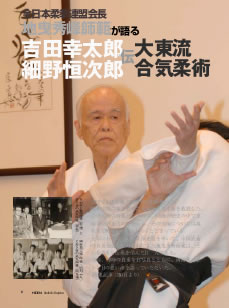 Hidemine Jibiki in Hiden Budo & Bujutsu Magazine
Hidemine Jibiki in Hiden Budo & Bujutsu Magazine
Hidemine Jibiki – Hakko-ryu, Daito-ryu Aiki-Budo, and “The Road to Softness”, Part 1
(translated by Christopher Li)
Ten years passed in hard Karate training and through a chance turn of events Hidemine Jibiki came to see weaknesses in his Karate. He was made aware of this when a drunken friend unexpectedly turned violent.
Coming to a Turning Point
Q: In the last interview you said that you had begun to have reservations about Karate….
A: About ten years had passed, and I had thrown my self entirely into Karate training, believing it to be a rational and practical form of self defense. Then, I was unable to pacify a friend who had become intoxicated. Karate focuses primarily upon punches and kicks, and there were no controlling techniques. I began to think that, when it comes right down to it, this would be insufficient as a form of self defense.
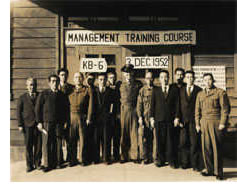 Hidemine Jibiki during his time as a translator
Hidemine Jibiki during his time as a translator
Q: And was that a major turning point for you?
A: Yes, it was. It was when I was around twenty-seven years old…
Held down with a single thumb?
Q: What happened then?
A: In any case, I began to look around. It was a time when there were none of the Budo magazines that we have today. I had no clue where to go. One day at the Kannon-sama in Asakusa I encountered something that can only be described as fate…
Q: Was that at Asakusa Temple?
A: That’s right. When I was a child I was raised in Shitaya, so I often went there to play.
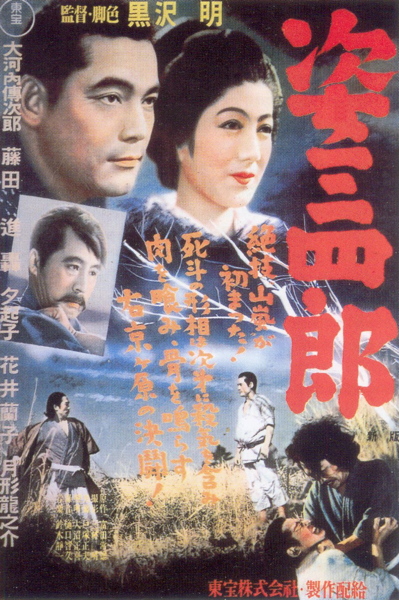 Akira Kurosawa’s first movie, an adaptation of the book “Sugata Sanshiro” – 1943
Akira Kurosawa’s first movie, an adaptation of the book “Sugata Sanshiro” – 1943
Q: So you felt a connection to this place.
A: At that time I met a fortune teller on the grounds of the temple. I’ve forgotten how we met, but the title on that person’s business card said “Jujutsu Shihan”. Judo was in its prime at the time, and everybody adored “Sugata Sanshiro” (姿三四郎). In the novel Jujutsu was just something that had been weeded out by the new Budo, Judo, so I thought it was really old-fashioned. But that person said that with Jujutsu one could hold an opponent so they couldn’t move with just a single thumb.
Q: Ehh! Just one thumb?
A: I thought “That’s ridiculous!” too. So I said “I do Karate, so could you try applying that technique?”, and they said “Well then, I’ll introduce you to my teacher” and wrote an introduction on the back of their business card.
My Karate is Destroyed
A: I went to visit the teacher in Omiya, intending to find out whether or not holding someone down with a single thumb was just bragging or not. At the entrance I pulled out the introduction from the previous day, stated my purpose, and was shown into the dojo. There was a tatami covered floor, about eight tatami mats with a low ceiling, it was a very old-fashioned place. The teacher was there…
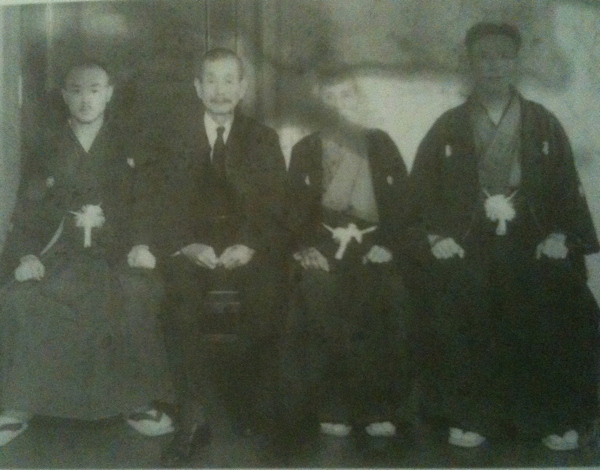 Ryuho Okuyama with Daito-ryu teacher Takeshi Maeda,
Ryuho Okuyama with Daito-ryu teacher Takeshi Maeda,
who was a student of Toshimi Matsuda
and his Shiatsu teacher Haizan Minami
General Iwane Matsui, second from left
Q: What was his name?
A: It was Ryuho Okuyama (奥山龍峰) of Hakko-ryu (八光流). I was told “I hear that you do Karate, so try hitting me as hard as you can”, but I don’t know what happened at the moment that I tried to strike him. Everything in front of me went dark, and it felt like fireworks were shooting out of my eyes. I shouted “it hurts, it hurts”, and I was thrown perfectly. (laughing) I understood later, but “Kote-gaeshi” had been applied to me. Now I teach Daito-ryu (大東流), and Okuyama Sensei was a student of the genius Bujutsu-ka of Daito-ryu, Sokaku Takeda. I became his student right then and there. (laughing)
Folding up a Judo Student
Q: What kind of an instructor was he?
A: He was of average weight and height with a round head and a mustache. I think that he was about fifty years old at the time. He even came to my wedding. He has already passed away, and has been succeeded by his son. He excelled at Shiatsu and combined that with Daito-ryu, to give birth to the new school of Hakko-ryu. He would advertise in popular magazines and was very publicly active.
Q: Were there many students?
A: Hmm, how many were there….? I think that there were very few real students, but people would come from all over the country to stay in that tiny dojo, and Shihans were produced very quickly.
Q: Very quickly?
A: It’s really impossible. He would also teach by correspondence. That made me a little suspicious, but there were some things that were amazing, too. We went to a seminar at a hot spring in Tochigi, and all of the participants were professional Budo-ka. A large man who had a seventh dan in Judo suddenly grabbed Sensei right in the middle of his lecture — maybe he was still feeling the drinks from the night before. (laughing) He grabbed the collar and sleeve of Sensei’s kimono, but when Sensei grabbed his forearm the man became unable to move. Then he folded the man up like a paper lantern. He screamed “Help me!” and Sensei finally released him, laughing uproariously. At the time I really admired the fact that his breathing was never disturbed, he held a folding fan in his other hand throughout the whole thing. After that I threw myself into the training more and more.
Hidemine Jibiki’s training in Jujutsu began from this time. Before long he would begin training with Tsunejiro Hosono (細野恒次郎) and Kotaro Yoshida (吉田幸太郎), both senior students of Sokaku Takeda.
Daito-ryu – the Ki World of Softness
Hidemine Jibiki encountered Jujutsu in his tenth year of Karate training. The techniques of Hakko-ryu Aiki-jujutsu’s Ryuho Okuyama have destroyed his Karate completely, and he finds himself drawn into a fascination with Jujutsu.
Shattered Karate
Q: You trained in the “hard” world of Karate, and then leaped into the “soft” world of Aiki-jujutsu. Was there much that you found surprising?
A: I was really surprised. When a body that has been conditioned in the “hard” way is struck with a hard fist it doesn’t hurt very much, but when the techniques of the soft fist are applied it is really painful. It’s a pain that permeates your body. Further, when you are pinned you are unable to move.
Q: I heard that you had done quite a bit of training in Karate…
A: I would condition my fingertips by thrusting them into a drum filled with soy or fava beans and strike the makiwara before going to sleep, in the mornings I would condition myself in silence before leaving for work. I would strike myself with milk bottles to condition my bones – that doesn’t just condition the bones and muscles for hardness, it also imparts flexibility. When I was a translator at the American army base at Kizarazu I had a foreigner grab me by the lapels, and he was stunned when I kicked him in the chin. (laughing) Since I had confidence in myself I didn’t think that Okuyama Sensei would be able to do anything like holding me down immovable with just a single thumb! But he did it to me easily. I couldn’t understand how I could be beaten that badly. In that one instant I lost all my enthusiasm for doing Karate. (laughing) Conversely, I had to know how that had happened.
The dojo had a different atmosphere.
Q: What were your impressions when you first encountered soft style training?
A: Since I had been doing hard style training for a long time I was stiff and tense, but when Okuyama Sensei entered it felt as if he had removed all of the power from his shoulders and his entire body was relaxed. I was impressed by the fact that the atmosphere in the dojo was so completely different. It was the complete opposite of the feeling of tension that filled the Karate dojo – I felt like a fish out of water.
Q: What was the training like?
A: At first I was taught by one of the senior students, starting with seated techniques. The techniques were applied from a seated position, but it hurt, it really hurt. (laughing) On the other hand, when Sensei entered the dojo the atmosphere would change abruptly and become very relaxed.
Ryuho Okuyama Sensei
Q: Did Okuyama Sensei have a sense of humor?
A: He was someone who moved with the dignity of an instructor. Since he would also be smiling you would become able to relax. However, in a way, I think that he was a genius. He would travel around Japan teaching Hakko-ryu, spending just a short time, a week to ten days, in each region. He had also practiced Shiatsu for a long time, so he would teach that at the same time.
Q: This was a time without television, so did this get a big response?
A: I think so. It was right after the war, and there were many among the returning soldiers who had an acquaintance with Budo, so he was able to interest many people. Of course, the people who came were people with skills, so he wouldn’t have been able to do it without confidence in himself.
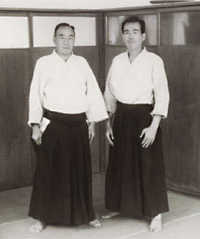 Hidemine Jibiki and Tsunejiro Hosono
Hidemine Jibiki and Tsunejiro Hosono
Tsunejiro Hosono Sensei
Q: I’ve heard that you were taught by Tsunejiro Hosono Sensei after Okuyama Sensei, how did that come about?
A: When my companions and I got together it would naturally lead to discussions of Budo, and I came to understand that Hakko-ryu was an offshoot of a thing called Daito-ryu. I searched for it, wanting to gain knowledge of the source art. I found a book called “Aiki-no-jutsu” (合気之術) by Ichiro Tateyama (立山一郎) in a bookstore. That writer was was a student of Aikido’s Morihei Ueshiba, and wrote a book exploring the origins of Aiki. When I made inquires with the writer, he turned out to be a fascinating person, and introduced me to Daito-ryu Aiki-jujutsu’s Hosono Sensei. Further, Hosono Sensei was living in Koiwa, and my parents also lived in Koiwa, so I had the home court advantage.
Q: What kind of person was he?
A: When I called upon him he was dressed in a casual Kimono, and he looked like a wealthy merchant. He was a gentle and peaceful person. He seemed like he would be the chief of the general affairs department in a corporation, and it turned out that he had actually held that position in a major corporation. (laughing) He didn’t seem like what you would call a Budo-ka. He was highly educated, when he sent you postcards they would include classical Japanese poetry. At that time he had retired and was teaching Aiki at the same time that he was also teaching Judo. In the past Judo-ka would naturally receive certification as osteopaths (整骨師), so he was also teaching that. When I said “I’ve been doing Hakko-ryu” he said that I already had the foundation and training began.
Q: What was different from your previous training?
A: In Hakko-ryu there were many techniques that focused on finger pressure on the pressure points, but since Daito-ryu is composed of Aiki techniques he taught me Aiki.
What is Aiki?
Q: Aiki is written as “matching Ki”, but what exactly is it?
A: Condensing “Ki” and focusing it. In terms of music, it is like matching tones. One focuses Ki at the place that the opponent is pressing down, when one does that the opponent becomes hooked onto the technique as if they are caught in the snare of a trap. One can say the same about Taijiquan. When I saw Taijiquan for the first time I thought “This is Aiki”.
Q: You started from the world of “Go” (“hard”), was it difficult for you to understand the world of “Ju” (“soft”)?
A: Ki is something that is inside the body, so it can’t be seen from outside. It is only when they are applied to you that one can first know the power of “Ki” techniques. It’s true for everybody, but you can’t master them just with intellectual understanding, at first you just don’t understand what to do. One cannot focus Ki when they have not developed their Ki, when one tries to relax they cannot. In the beginning I would become frustrated and use Karate, or give in to using power to throw at times when I was struggling… (laughing) At that time even Karate was quite rare, but now it has become really popular. (laughing)
Q: Was there a moment that you would describe as “eye-opening”?
A: I came to understand little by little. But when I watched Hosono Sensei’s techniques I just couldn’t understand. I would grab Sensei’s index finger with all of my strength, and when Sensei moved I would be tossed right away. It’s something that would be inconceivable in the world of strength. (laughing)
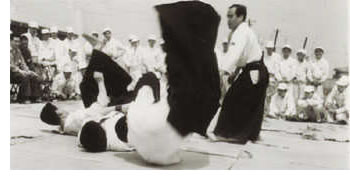 Daito-ryu Aiki-jujutsu demonstration by Tsunejiro Hosono
Daito-ryu Aiki-jujutsu demonstration by Tsunejiro Hosono
Soft training calls out to a person.
A: Because it was such a mystery, from dawn until dusk I couldn’t get it out of my head. In the end, it’s a matter of the quality of the tissue and the inside of the body, so one can’t understand from outside. In time I noticed that I was thrown because the joints were reversed, but I just kept researching – it’s not this, it’s not that. At that time my training partner was Kazuo Yokota Sensei (横田和男). We’d been training together since the Hakko-ryu days, and we’d go to the coffee shop to put our heads together. We’d grab each other’s forearms and hands – it’s not this, it’s not that… (laughing) In my Karate days I would train alone in silence, but this couldn’t be trained alone.
Q: It’s thought that there is something about soft training that calls out to a person…
A: Yes, that’s right. When applying techniques one must match their Ki to the Ki of the opponent. It must be that a connection from one person to the other is created there. We apply techniques on each other and cause pain, so when we are happy to act as partners for each other it must improve our chemistry with each other. (laughing)
Published by: Christopher Li – Honolulu, HI

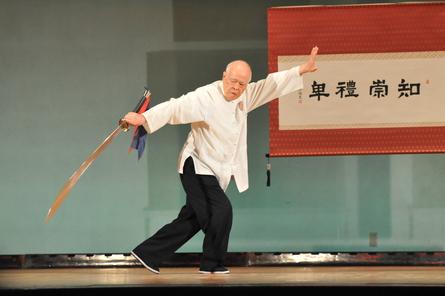



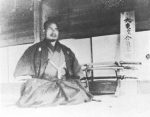



Leave a Reply